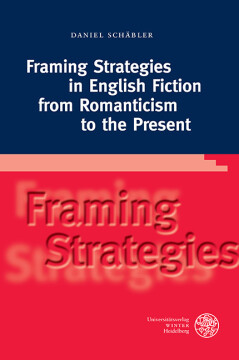
BUCH
Framing Strategies in English Fiction from Romanticism to the Present
Anglistische Forschungen, Bd. 440
2014
Zusätzliche Informationen
Bibliografische Daten
Abstract
Cognitive and material frames surround us and serve as a central strategy of making sense of the world. Throughout centuries, literary texts reflect on the power of the frame. The thesis explores the way framed narratives have changed in form and function, and retraces the nexus between cultural context and narrative structure. It traces formal experiments with narrative framings back to early Romanticism. Starting with a bestseller from the 18th century, Horace Walpole’s intricately framed ‘The Castle of Otranto’ (1764), and moving on to a later proponent of Romantic fiction, Mary Shelley’s ‘Frankenstein’ (1818), via Joseph Conrad’s proto-Modernist ‘Heart of Darkness’ (1899/1902), to an example of postmodern historiographic metafiction, Adam Thorpe’s ‘Hodd’ (2009), the study travels through literary history, and, using these influential texts as examples, aims to show how frame-narratives have evolved both in form and function.
Inhaltsverzeichnis
| Zwischenüberschrift | Seite | Aktion | Preis |
|---|---|---|---|
| Contents | 7 | ||
| 1 Introduction | 9 | ||
| 1.1 Framing as World Making | 9 | ||
| 1.2 Material and Cognitive Frames as Fundamental Epistemological Categories | 16 | ||
| 1.3 Placing the Story: Framing-Strategies in Narrative Texts | 19 | ||
| 1.4 Paratexts as Thresholds Into the Story-World | 22 | ||
| 1.5 The Structure of Framings | 25 | ||
| 1.6 Beyond Classical Narratology. From the Text to Cultural and Reader Centred Approaches | 28 | ||
| 2 Framing the Gothic | 45 | ||
| 2.1 Survey of Criticism | 45 | ||
| 2.2 Contextualization: The Emerging Book-Market, Authorship, and the Reader | 54 | ||
| 2.3 Prefatorial Strategies and Readerly Interaction | 58 | ||
| 2.4 From The Castle of Otranto to Frankenstein; or, The Modern Prometheus: Romantic Hermeneutics and the Function of Paratexts | 78 | ||
| 3 Framing the Monstrous: Frankenstein as a Romantic Critique of Science | 81 | ||
| 3.1 Outline of the Argument | 81 | ||
| 3.2 Survey of Criticism | 83 | ||
| 3.3 Frankenstein in its Cultural Context: A Romantic Critique of Science | 90 | ||
| 3.4 Gateways Into the Text: Frankenstein’s Paratexts | 98 | ||
| 3.5 Cognitive-Narratological Approach: How the Framings Influence the Reading Process | 104 | ||
| 3.6 Narrative Transmissions | 107 | ||
| 3.7 Depicting Monstrosity: Reading, Textuality, Framing the Abject | 123 | ||
| 3.8 Romanticism, Ironies, and the Role of the Reader | 133 | ||
| 3.9 From Frankenstein to Heart of Darkness: Scepticism and Communicability | 137 | ||
| 4 Framing the Heart of Darkness | 139 | ||
| 4.1 Survey of Criticism | 139 | ||
| 4.2 Narrative Structure and Cultural Context: Conrad and Modernism | 150 | ||
| 4.3 The Frame Structure: Subversion of Level and Voice | 155 | ||
| 4.4 The Phonographical Principle and the Disembodiment of Voice | 160 | ||
| 4.5 Prefiguring Psychoanalysis | 171 | ||
| 4.6 Reading Strategies: Stacks and Patterning | 177 | ||
| 4.7 From Heart of Darkness to Hodd: (Post)Modern Framing Strategies | 179 | ||
| 5 Framing the Myth: Adam Thorpe’s Hodd | 181 | ||
| 5.1 Outline of the Argumen | 181 | ||
| 5.2 Cultural Context: Postmodernism, the Author Function, and Historiographic Metafiction | 184 | ||
| 5.3 Textual Levels | 190 | ||
| 5.4 The Prefaces: “a tantalizing human presence” | 192 | ||
| 5.5 The Main Text: Myth and Trauma | 197 | ||
| 6 Conclusion: The Logic of Framing Strategies | 217 | ||
| Bibliography | 229 |


 Publishing Platform by CloudPublish
Publishing Platform by CloudPublish